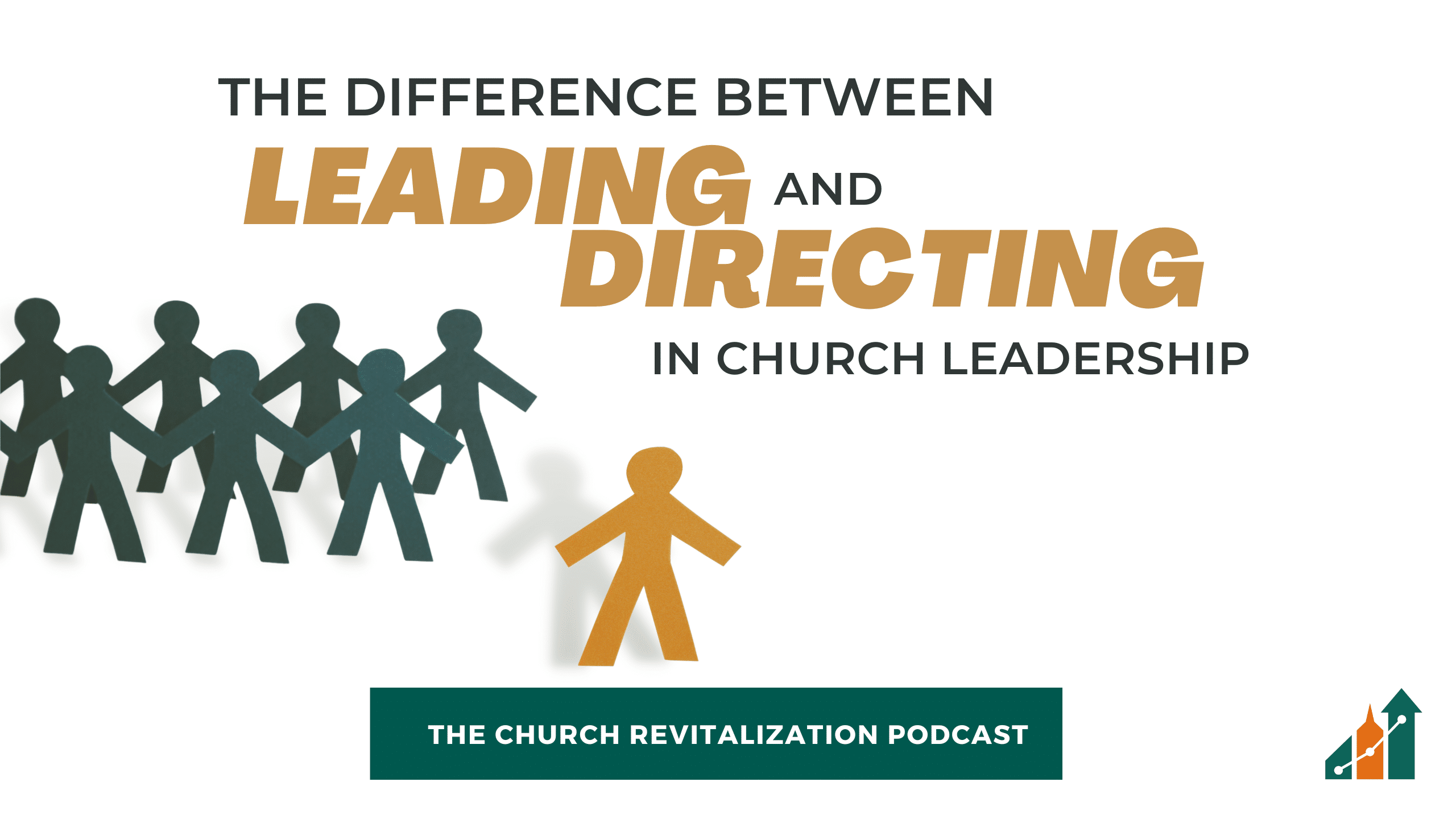The Church Revitalization Podcast – Episode 179
Leading and directing are both crucial functions of effective church leadership, but they involve different approaches and goals.
Just like a washing machine has access to both hot and cold water, as a pastor, you have two leadership “taps”: leading and directing. However, it can be difficult to know when to apply each approach. Unfortunately, many church leaders struggle to understand the difference between leading and directing and how to apply them appropriately.
Using the wrong temperature when washing clothes can lead to disastrous consequences, and similarly, defaulting to directing when you need to be leading can cause issues in your church.
Our goal is to help you better understand the difference between leading and directing and how to apply each approach depending on the situation. Furthermore, we want to help you improve the more challenging task of leading.
Subscribe below to never miss an episode.
Defining Leading vs Directing
The first step to balancing leading and directing effectively is to understand the clear difference between the two. For most leaders, directing is the default mode. This approach involves giving instructions, assigning tasks, and prescribing actions. In other words, it means saying “here’s a task I need you to do; get it done.”
Directing is important as it provides clear expectations and feedback, which helps people feel more effective, especially when working with frontline volunteers who have limited time and energy. Volunteers want a leader to provide them with clear direction on what needs to be done and resources to achieve their goals.
On the other hand, leading, while appearing to be easier because it is more “hands-off,” is actually a much more complex task. Leading involves inspiring and motivating people to have ownership of their role and a shared vision for the direction of the church. This approach engenders participation and cultivates consensus and excitement about where the church is going and the role that people have to play in achieving the vision.
Leading is especially crucial when working with other staff and key stakeholders and is critical for higher-level positions. For example, the Lead Pastor shouldn’t have to map out the day-to-day tasks for the Youth Pastor or Children’s Director, but should communicate a clear vision and goal for the entire church that the staff understands and works hard to create plans to accomplish. Leading avoids micromanagement while retaining a high degree of focus on setting a standard for success.
Both leading and directing can be used to get things done in the church, but leading is the more powerful tool when appropriately applied.
The Scope of Leading vs Directing
In the context of church leadership, leading and directing have different scopes. Leading involves inspiring and motivating people at all levels of the church, and has the potential to create a unifying effect across all ministry areas. By establishing a culture that promotes healthy relationships among staff, volunteers, and the congregation at large, leading sets a vision for the whole church or ministry.
On the other hand, directing is more focused and narrow in scope. It helps people apply the overall vision to a specific goal, plan, or role. Directing involves identifying the critical pathways to success and determining the tasks needed to achieve a specific goal. However, directing without leading can breed resentment and make serving in ministry difficult and joyless.
In church leadership, both leading and directing have their place, but it’s important to know when to apply each one. Understanding the scope of each function can help church leaders balance them more effectively, and create a healthy and unified ministry culture.
Identify the Simplest Solutions First
Systems thinking requires that you prioritize solutions to problems. Think about what the root causes of your problems could be, name a solution to that problem, and then prioritize these action items from easiest to hardest. Or, order the solutions from fastest to slowest. Or, you consider them from most expensive to least resource-intensive. Or, order the solutions from most likely to cause conflict to the least.
There are lots of ways to prioritize solutions, but at its core, you want to consider what causes the least friction (time, resources, relationships) to most. Then, make a plan to follow through on those solutions. We’ve discussed the Eisenhower Matrix before; essentially, prioritizing your to-do list by what’s important and urgent down to what’s not important and not urgent.
The solutions to bridge the gap between your reality and your vision are likely to fall in the “Important, but Not Urgent” category. These are often the tasks that separate high-performing individuals and organizations from those that are tossed about by the tyranny of the urgent and the eternal present. Only the churches that are truly committed to achieving their vision will do the hard work of prioritizing solutions to their problems and following through on those solutions, even when they aren’t urgent.
The Role of Communication in Leading vs Directing
As previously mentioned, leading involves communicating the vision above all else. People want to know where the church is headed, and they want to be part of something greater than themselves. However, leading isn’t solely about using flowery language to describe the church’s future, like a second-rate motivational speaker.
Leading must also involve articulating the church’s values. What motivates the church at its core, and why should people care about their role? Expressing the power of the church’s values is life-affirming and helps shape the culture.
In addition, sharing the church’s clear objectives can help track the milestones necessary to achieve the overall vision, inspiring and motivating people to continue moving forward when they’re tired or when things get tough.
On the other hand, directing primarily entails communicating instructions and expectations. Providing clear boundaries for success and failure, and using feedback to ensure that tasks are completed correctly.
Directing is vital because volunteers are more likely to quit due to a lack of clear expectations than because they feel micromanaged. However, volunteer teams will never achieve their full potential if they only perceive their role through job descriptions, task lists, and schedules.
Consider working with your greeter team. It’s crucial to explain where they should stand, how to speak with guests, and how to collect Connection Cards. Clear instructions will ensure that you have an excellent greeter ministry. However, to have an exceptional greeter ministry, the greeters must be led. They need to comprehend that they’re not just a friendly face; they’re the first line of the gospel in your church.
Your greeters are the initial interaction visitors have with the Good News about Jesus on a Sunday morning, setting the tone for their receptiveness to the message from the Pastor. In essence, the greeters can enhance or detract from the sermon’s effectiveness.
Leading is communicating the value of the role, not just the tasks. Truly transformational leadership in the church requires the ability to help people see beyond the task to the bigger vision and purpose.
The Importance of Influence in Leading vs. Directing
As the saying goes, “A leader without followers is just a man going on a walk.” The real difference between leading and directing is the ability to influence people in a particular direction.
Less experienced or weaker leaders may rely on their positional authority to get things done, like telling their kids to clean their room “because they said so.” While there are times when it’s necessary to use authority, if you lack the ability to influence through other means, your leadership is likely to fall flat.
Leading involves using influence and persuasion to bring people on board with a vision and inspire them to work towards common goals. If you feel that you’re weak in this area, take time to learn more about how to use language, emotion, and clarity to guide your church forward. Jesus was a master at this. He not only used facts and logic to rebut the Pharisees, but also leveraged compassion, language, and the emotion of the moment to transform people. Reading the gospels with this lens can provide valuable insights and lessons from the wisdom of Jesus.
Leading as the Key to Creativity
Directing tends to lean on established procedures to ensure tasks are completed in a prescribed way. If any leader in your church has ever uttered the words, “We’ve always done it this way,” the odds are good that he is guided more by directing than leading.
This isn’t to say that processes and systems are always bad. Far from it! In fact, the lack of effectiveness in ministry is often due to the lack of a system or process. Some churches think they have a system, when in fact they just have a bad habit or a routine.
Leading enables innovation and the development of new processes and systems that help to accomplish the defined goals. But in order to craft the right systems and processes, you’ll need to unlock the collective creativity of your entire team.
Leaders who are stuck in the “directing” mode often feel the need to be the sole developer of systems and processes. Their way is the only way. But this isn’t effective leadership.
Transformational leaders find ways to cultivate and channel the creativity of the entire team, enabling the best ideas to rise to the top, and then streamlining those ideas to create clear plans to achieve their goals.
Leading is collaborative. Directing is stifling.
Leading builds consensus. Directing demands conformity.
If you want to innovate as a church and ensure that you don’t get stuck in dysfunctional patterns of ineffective ministry, you need to lead, not direct.
In conclusion, leadership and directing are two very different approaches to guiding a church or ministry. While directing may have its place in certain situations, leadership is what truly enables a church to thrive and fulfill its mission. Effective leaders inspire and influence others to work towards common goals, foster creativity and innovation within their teams, and build consensus rather than demand conformity.
By following the example of Jesus and investing in the development of leadership skills, church leaders can create a culture of growth, innovation, and effectiveness that will impact the Kingdom. Remember, it’s not enough to simply direct people to do things. True leadership involves inspiring and empowering others to join you on a shared journey towards a greater purpose.
BONUS: Watch this episode on YouTube.


Scott Ball is the Vice President and a Lead Guide with The Malphurs Group. He lives in East Tennessee with his wife and two children. (Email Scott).

